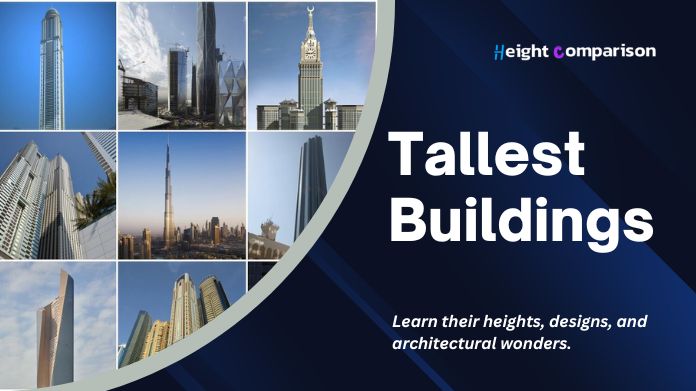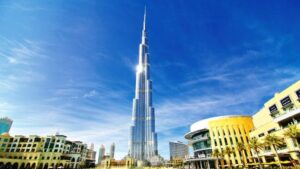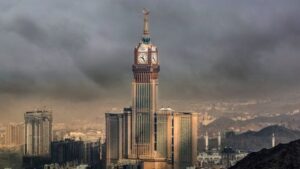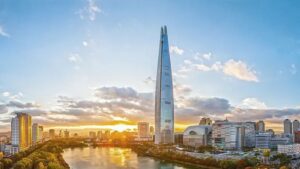As humanity continues to push the boundaries of architectural innovation and engineering prowess, skyscrapers have become iconic symbols of modern civilization.
Towering over city skylines, these architectural marvels represent the pinnacle of human achievement in vertical construction. In this Height Comparison article, we delve into the world of skyscrapers to explore the world’s five tallest buildings.
From the towering heights of the Burj Khalifa in Dubai to the sleek silhouette of the Shanghai Tower in China, these architectural wonders stand as a testament to human ingenuity and ambition. We’ll examine the distinctive features, awe-inspiring designs, and engineering feats that distinguish these skyscrapers from their peers.
Join us on a journey to discover the tallest buildings in the world and marvel at the remarkable structures that dominate the urban landscapes of our global cities.
Whether you’re an architecture enthusiast, a traveler seeking breathtaking views, or simply curious about the heights humanity can reach, this article promises to offer insights into the towering achievements of modern architecture.
List of 5 Tallest Buildings in the World

| Building Name | Location | Height (m/ft) | Completion Year | Architect | Cost (USD) | Notable Features |
|---|---|---|---|---|---|---|
| Burj Khalifa | Dubai, United Arab Emirates | 828 m (2,717 ft) | 2010 | Skidmore, Owings & Merrill LLP (SOM) | $1.5 billion | World’s tallest building from 2010-2023, Islamic architecture-inspired design, Observation decks on 124th, 125th, and 148th floors, Dubai Fountain at its base |
| Shanghai Tower | Shanghai, China | 632 m (2,073 ft) | 2015 | Gensler | $2.4 billion | Twisting, asymmetrical form, Double-skin facade for energy efficiency, World’s highest indoor observation deck (118th floor), World’s fastest elevators (20.5 m/s) |
| Abraj Al-Bait Clock Tower | Mecca, Saudi Arabia | 601 m (1,971 ft) | 2012 | Dar Al-Handasah | $15 billion | Part of Abraj Al-Bait complex near Masjid al-Haram, Massive clock face visible from 25 km away, 23-meter-tall golden crescent at its pinnacle |
| Ping An Finance Center | Shenzhen, China | 599 m (1,965 ft) | 2017 | Kohn Pedersen Fox Associates (KPF) | $1.5 billion | Faceted facade with 1,700 tons of 316L stainless steel, Observation deck on the 116th floor, Symbolizes Shenzhen’s growth as a global financial center |
| Lotte World Tower | Seoul, South Korea | 555 m (1,819 ft) | 2016 | Kohn Pedersen Fox Associates (KPF) | $3.5 billion | Design inspired by traditional Korean ceramics and calligraphy, Seoul Sky observatory on 117th-123rd floors, World’s highest glass-floored observation deck, World’s fastest double-deck elevators (10 m/s) |
Here’s an overview of the five tallest buildings in the world:
1. Burj Khalifa – Dubai, United Arab Emirates

Height: 828 meters (2,717 feet)
Completed: 2010
Architect: Skidmore, Owings & Merrill LLP (SOM)
Cost: $1.5 billion
The Burj Khalifa is an architectural wonder that dominates the Dubai skyline. With 163 floors, it held the title of the world’s tallest building from 2010 until the completion of the Jeddah Tower in Saudi Arabia. The tower’s design is inspired by Islamic architecture, featuring a Y-shaped plan and a triple-lobed footprint that optimizes views and minimizes wind forces.
The Burj Khalifa offers a mix of residential apartments, the Armani Hotel Dubai, office spaces, and several exclusive restaurants. Visitors can experience breathtaking views from the observation decks on the 124th, 125th, and 148th floors. The tower also features the Dubai Fountain, the world’s most extensive choreographed fountain system, at its base.
2. Shanghai Tower – Shanghai, China

Height: 632 meters (2,073 feet)
Completed: 2015
Architect: Gensler
Cost: $2.4 billion
The Shanghai Tower symbolizes China’s rapid urban development and technological advancement. Its twisting, asymmetrical form consists of nine cylindrical buildings stacked atop each other, with a double-skin facade that improves energy efficiency and reduces wind loads.
The tower features office spaces, luxury hotels, retail spaces, and cultural amenities. The Shanghai Tower Observatory on the 118th floor is the world’s highest indoor observation deck, offering panoramic city views. The tower also boasts the world’s fastest elevators, which travel up to 20.5 meters per second.
3. Abraj Al-Bait Clock Tower – Mecca, Saudi Arabia

Height: 601 meters (1,971 feet)
Completed: 2012
Architect: Dar Al-Handasah
Cost: $15 billion
The Abraj Al-Bait Clock Tower is the central feature of the Abraj Al-Bait complex, located near the Masjid al-Haram in Mecca. The tower houses the Clock Tower Museum, luxury hotels, a five-story shopping mall, prayer halls, and a lunar observation center.
The tower’s most distinctive feature is its massive clock face, visible up to 25 kilometers away. The clock face measures 43 meters in diameter and is illuminated by over 2 million LED lights. The clock tower also features a 23-meter-tall golden crescent at its pinnacle, making it one of the most recognizable landmarks in the Islamic world.
4. Ping An Finance Center – Shenzhen, China

Height: 599 meters (1,965 feet)
Completed: 2017
Architect: Kohn Pedersen Fox Associates (KPF)
Cost: $1.5 billion
The Ping An Finance Center is a testament to Shenzhen’s rapid growth as a global financial center. The tower’s unique faceted facade comprises 1,700 tons of 316L stainless steel, which reflects light and creates a shimmering effect that changes throughout the day.
The tower houses the Ping An Insurance Company office spaces, luxury hotels, high-end retail outlets, and a large podium with a multi-level atrium. The observation deck on the 116th floor offers visitors stunning views of Shenzhen and the surrounding region.
5. Lotte World Tower – Seoul, South Korea

Height: 555 meters (1,819 feet)
Completed: 2016
Architect: Kohn Pedersen Fox Associates (KPF)
Cost: $3.5 billion
The Lotte World Tower is a modern landmark redefining Seoul’s skyline. This tapered design draws inspiration from traditional Korean ceramics and calligraphy, showcasing the harmony between contemporary architecture and Korean heritage.
The tower features diverse functions, including office spaces, luxury residences, the Lotte Hotel World, retail spaces, and cultural facilities. The Seoul Sky Observatory on the 117th-123rd floors offers visitors a panoramic view of the city and features the world’s highest glass-floored observation deck. The tower also boasts the world’s fastest double-deck elevators, which travel up to 10 meters per second.
Wrapping Up
The five tallest buildings in the world stand as remarkable testaments to human ambition, ingenuity, and engineering prowess. From the soaring heights of the Burj Khalifa in Dubai to the sleek silhouette of the Lotte World Tower in Seoul, each skyscraper represents a triumph of architectural innovation and technological advancement.
These towering structures not only redefine the skylines of their cities but also serve as iconic landmarks that capture the imagination of people around the globe.
They inspire awe and admiration as symbols of progress and modernity, drawing visitors from far and wide to marvel at their sheer magnitude and beauty.
Whether it’s the mesmerizing views from their observation decks or the intricate designs of their facades, the tallest buildings in the world continue to delight and inspire us, reminding us of the boundless possibilities of human achievement in architecture and construction.






